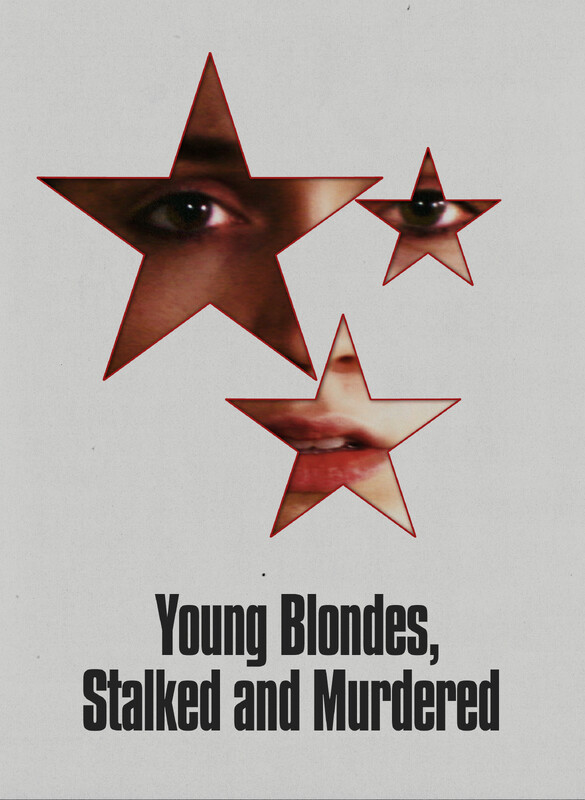Director Nick Funess, Actress Samantha Carroll, and Cinematographer Corentin Leroux Discuss their new Independent Horror Film.

ZekeFilm: Young Blondes, Stalked and Murdered feels like a unique mix between something along the lines of Giallo and French New Wave. Were there references on your mind with the inception of the film?
Nick Funess (Director): Yes, there were quite a few. I apologize for the long list I’m about to give here… Dario Argento, Friedkin, De Palma, some Todd Haynes, Gus Van Sant (especially Paranoid Park and its dreamier sequences), some Michael Haneke (I like keeping things static), Irvin Kershner (his Eyes of Laura Mars has some great cutty editing), oh, that teen slasher Cry Wolf from 2005 all had some influence. Claude Chabrol was a big one too, especially in his way of making tension out of anything (see La Ceremonie). There are a few French directors (old and new) who are really good at that. Chantal Akerman of course with Jeanne Dielman, which I feel is like the north star for a lot of arthouse movies, but it really is a valuable experience. Another big influence was this American-French film called 29 Palms by Bruno Dumont, where they do a lot with little. Also this French, sort of neo-giallo, that came out in 2011 called Last Screening by Laurent Achard–it’s kind of the ideal art-horror, but doesn’t pull its punches. Ok, I’m done!
Corentin Leroux (Cinematographer): Nick and I watched a couple films during pre-production. We talked about tone and pacing a lot. We have had the privilege of knowing each other since 2015, we speak a similar language
ZF: There’s also a subversive quality to the film, from the salacious title that is then inverted and the scenes that go on in a way that almost feels like a challenge to the viewer. How much were you thinking of this film as a direct challenge to the viewer while making it?
Nick Funess (Director): We definitely were keeping that in mind because I was most interested in the build-up to the kill. That was guiding the movie. In slashers or giallo or any horror, I became kind of obsessed with the construction of the kill or the scare; the trap. John Carpenter and Tobe Hooper are kind of masters at it. James Wan too. Two French films, Stranger by the Lake, as well as Catherine Breillat’s Fat Girl, particularly the finale, really revel in a Hitchcockian tension that I hoped to replicate. Another film that plays with that dread really incredibly well is Day Night Day Night by Julia Loktev, don’t want to spoil it but check it out (the opening monologue might sound familiar).
I wanted to play with these expectations and yes, challenge people, and for a few, probably bother them. I wanted to make one long, protracted “pre-kill” scene. Not that I’m above making a traditional slasher or something, but there were budgetary constraints and there was also a desire to make a character study. Originally, we were going to hold back even more, and show and mention the killer even less, but I think we came out with a good ratio. We wanted to go for a kind of cinematic “edging.” Which, like in real life, some people are into and some aren’t. Understandably!
ZF: The film delves into the psychology of success and the lengths to which individuals will go to achieve their dreams. Can you elaborate on your decision to focus on this theme and how you developed it through the characters of Stacy and Josie?
Nick Funess (Director): I was interested in this idea of waiting and that kind of goes back to this “edging” or “pre-kill” dread. In your 20s, it really feels like you’re always waiting for something, any kind of break from the toil of figuring out what’s next. Whether that’s finding a job or a place to live or trying to make friends. I’m sure some COVID anxiety also found its way into this, as the script was formed during that time.
For the two main characters, I wanted to look at two people who are on similar paths, but whose blocks are falling into place a little differently. I didn’t want it to be a totally stark contrast between the two, where like Josie is without a doubt on her way and Stacy isn’t. Josie still has her own obstacles to face as well.
ZF: Stacy’s character exhibits a mix of desperation and determination. How did you and Samantha Carroll work together to bring out these complex emotions in her performance?
Nick Funess (Director): Sam did pretty much all of the heavy lifting. I just tried to nudge her onto a certain track. I had a few people, whether they were from books or movies or real life, that I thought would make a good foundation for Stacy. I sent Sam some materials, like Joan Didion excerpts or a music playlist, that might get her into that headspace. I don’t know if she ever looked at them haha, but it was helpful for me too, to keep those touchstones in mind when directing.
Samantha Carroll (Actress): They say you have to be a little delusional to follow your dreams, so I can already relate to that aspect. I think the desperation part comes in when Stacy begins to believe that any recognition, including being hunted by a serial killer, equates to success. I also think it’s common, on a lesser scale, for people to mistake the appearance of success for genuine artistic fulfillment, and so our collaboration was focused on finding a balance between ambition and authenticity.
ZF: You made a deliberate choice to keep other characters in the background, often with blurred or obscured faces. Was this something thought of from the beginning or did it evolve as the production went along and reached the shooting stage?
Nick Funess (Director): It kind of came into fruition during pre-production when we were making the shot list. I wanted to keep things simple but I also thought it would be cool to just keep the focus on Stacy. It was also a bonus in terms of practicality, with less coverage to get.
I also wanted to have the people offscreen be ones mainly in positions of power. Like faceless, strange, or indifferent entities. Because that’s what it feels like when you interview for a job or meet a connection to potentially “further your career.” I hoped to try and show that alienation.

ZF: The audition scene with Sacha is particularly disorienting and tense. Can you walk us through the process of creating this scene and its significance to you?
Nick Funess (Director): With the Sacha scene, I knew I wanted to show his face as little as possible if we could. I thought that would add to the unease, especially because you hear his voice so much, it hopefully would grow unbearable to not be able to put a face to it. And of course Zach Grant, who played Sacha, brought so much to it. He is amazing and professional and played the role to a tee. He could do a lot by just how he walked or put his hands to his sides or whispered a word.
Since the scene was essentially the climax/midpoint, I hoped that, for the viewer, it felt like, “Ok, now we’re going to get to the good stuff, the murder, some action,” something to relieve us from Stacy’s sad little world. I found it interesting if we could evoke that feeling, a kind of basic feeling that drives entertainment really, of desiring violence to occur. And then finally, subvert their expectations.
Corentin Leroux (Cinematographer): The audition scene stood out in the script as the biggest set piece of the film as it really elevated the stakes midway through the story. We shot listed and scouted that sequence heavily. There were many pages to shoot that day and the house we shot at in Glendale had these huge window panes that made lighting continuity a challenge. Our amazingly talented and passionate crew helped us find the spark on set and realize the vision.
ZF: Los Angeles seems to play a significant role in the film, almost like another character. LA usually feels noisy and busy when it plays as a character in a film though (with some exceptions, Lynch being one). What was your thought process on focusing on the city’s presence in the film and was that a challenge while filming?
Nick Funess (Director): When you film here it is kind of unavoidable that its presence makes its way into the movie. But I know Coco and Matt, our producer, and I, we wanted to go for a ghost town atmosphere; horror could be lurking around anywhere. It was actually a benefit of it being shot during COVID, the desolation was amped up.
I also didn’t want to go over the top with the cultural signifiers. So, that meant no Hollywood Sign. Or the Walk of Fame. Or Knickerbocker Building (sorry Coco haha). I didn’t want Hollywood to feel all that special. Because it’s not! There are some nice hills though.
LA really can be, above all, a lonely and weird place. Especially having to drive everywhere–you go from one mode of isolation to the next. We shot so many driving scenes that didn’t get used haha probably for the best though, then people would’ve really been bored.
Corentin Leroux (Cinematographer): Loneliness is a big theme in the film. We chose locations that would reflect this theme and worked off Nick’s minimalist art direction/negative space references.
ZF: This is your debut feature. Can you share any insights into what you’re planning next, and how the experience of making “Young Blondes, Stalked and Murdered” has influenced your future projects? Also, will future projects have a similar tone or are you hoping to go in other directions?
Nick Funess (Director): We’re actually in the midst of editing our second feature. It’s called The Hedonist. It’s more of a comedy of the absurd, deadpan variety. There will be sex and nudity and blood and violence. In tasteful amounts. It’s not horror, but there are some elements of it. Some kind of horror I think will inevitably be in everything I make. Oh, and my parents are going to be acting in supporting roles for it.
I think YBSM will somehow inform probably every future project. It certainly laid the groundwork for the stories I want to tell; stories about sad, awkward people and the sad, awkward, or scary, situations they put themselves in. I like putting people into cringe-worthy situations and seeing how it unfolds. So I’m looking forward to doing more of that.
ZF: What advice would you give to aspiring cinematographers who are looking to work on independent horror films? Especially those who want to film in a similar style and want to subvert the norm that a lot of horror films take?
Corentin Leroux (Cinematographer): Horror is fun and can be done on a budget. It’s a great genre to explore early in our careers. There are tropes, structures, and motifs to play off of and so many opportunities to push boundaries.


